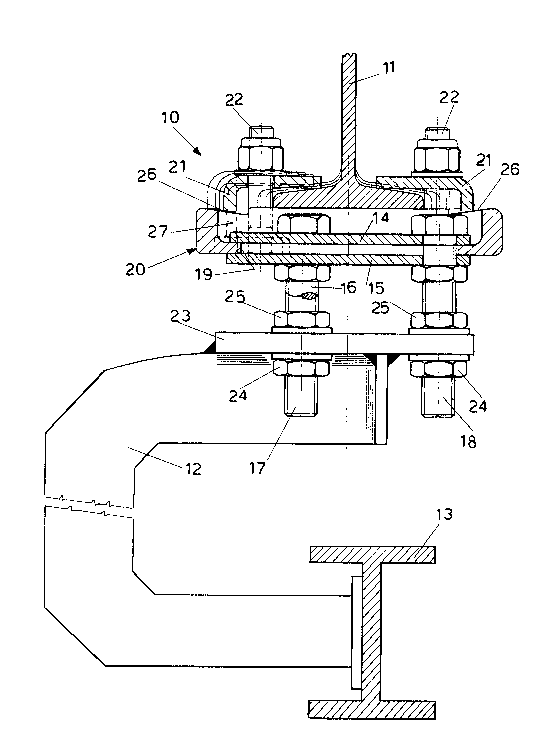Une partie des informations de ce site Web a été fournie par des sources externes. Le gouvernement du Canada n'assume aucune responsabilité concernant la précision, l'actualité ou la fiabilité des informations fournies par les sources externes. Les utilisateurs qui désirent employer cette information devraient consulter directement la source des informations. Le contenu fourni par les sources externes n'est pas assujetti aux exigences sur les langues officielles, la protection des renseignements personnels et l'accessibilité.
L'apparition de différences dans le texte et l'image des Revendications et de l'Abrégé dépend du moment auquel le document est publié. Les textes des Revendications et de l'Abrégé sont affichés :
| (12) Demande de brevet: | (11) CA 2136495 |
|---|---|
| (54) Titre français: | SUPPORTS A DISQUES POUR TRANSPORTEUR AERIEN |
| (54) Titre anglais: | DISK-TYPE ADJUSTABLE SUPPORTING DEVICE FOR OVERHEAD RUNWAYS |
| Statut: | Réputée abandonnée et au-delà du délai pour le rétablissement - en attente de la réponse à l’avis de communication rejetée |
| (51) Classification internationale des brevets (CIB): |
|
|---|---|
| (72) Inventeurs : |
|
| (73) Titulaires : |
|
| (71) Demandeurs : |
|
| (74) Agent: | SMART & BIGGAR LP |
| (74) Co-agent: | |
| (45) Délivré: | |
| (22) Date de dépôt: | 1994-11-23 |
| (41) Mise à la disponibilité du public: | 1996-05-24 |
| Licence disponible: | S.O. |
| Cédé au domaine public: | S.O. |
| (25) Langue des documents déposés: | Anglais |
| Traité de coopération en matière de brevets (PCT): | Non |
|---|
| (30) Données de priorité de la demande: | S.O. |
|---|
A supporting device (10) for overhead runways comprises a
fastening and adjusting coupling for connecting a bracket
(12) (the lower end of which is secured to the rail (13))
to an upper suspension beam (11). The coupling comprises a
first (20) and a second (23) element for connecting the
beam to the bracket, the first element defining a
circumferential rim (19), two parallel plates (14, 15)
being interconnected by bolts (16, 17, 18) which
reciprocally close together to grip said circumferential
rim between the plates thereby enabling the reciprocal
rotation of the element and plates around a vertical axis.
The plates (14, 15) have means for connecting them to the
second element which are adjustable to allow adjustment of
the reciprocal gap between the first and second element.
Note : Les revendications sont présentées dans la langue officielle dans laquelle elles ont été soumises.
Note : Les descriptions sont présentées dans la langue officielle dans laquelle elles ont été soumises.

2024-08-01 : Dans le cadre de la transition vers les Brevets de nouvelle génération (BNG), la base de données sur les brevets canadiens (BDBC) contient désormais un Historique d'événement plus détaillé, qui reproduit le Journal des événements de notre nouvelle solution interne.
Veuillez noter que les événements débutant par « Inactive : » se réfèrent à des événements qui ne sont plus utilisés dans notre nouvelle solution interne.
Pour une meilleure compréhension de l'état de la demande ou brevet qui figure sur cette page, la rubrique Mise en garde , et les descriptions de Brevet , Historique d'événement , Taxes périodiques et Historique des paiements devraient être consultées.
| Description | Date |
|---|---|
| Inactive : CIB de MCD | 2006-03-11 |
| Le délai pour l'annulation est expiré | 2002-11-25 |
| Demande non rétablie avant l'échéance | 2002-11-25 |
| Réputée abandonnée - omission de répondre à un avis sur les taxes pour le maintien en état | 2001-11-23 |
| Inactive : Abandon.-RE+surtaxe impayées-Corr envoyée | 2001-11-23 |
| Demande publiée (accessible au public) | 1996-05-24 |
| Date d'abandonnement | Raison | Date de rétablissement |
|---|---|---|
| 2001-11-23 |
Le dernier paiement a été reçu le 2000-11-02
Avis : Si le paiement en totalité n'a pas été reçu au plus tard à la date indiquée, une taxe supplémentaire peut être imposée, soit une des taxes suivantes :
Veuillez vous référer à la page web des taxes sur les brevets de l'OPIC pour voir tous les montants actuels des taxes.
| Type de taxes | Anniversaire | Échéance | Date payée |
|---|---|---|---|
| TM (demande, 3e anniv.) - générale | 03 | 1997-11-24 | 1997-11-05 |
| TM (demande, 4e anniv.) - générale | 04 | 1998-11-23 | 1998-10-28 |
| TM (demande, 5e anniv.) - générale | 05 | 1999-11-23 | 1999-10-26 |
| TM (demande, 6e anniv.) - générale | 06 | 2000-11-23 | 2000-11-02 |
Les titulaires actuels et antérieures au dossier sont affichés en ordre alphabétique.
| Titulaires actuels au dossier |
|---|
| FATA AUTOMATION S.P.A. |
| Titulaires antérieures au dossier |
|---|
| GIORGIO DEANDREA |